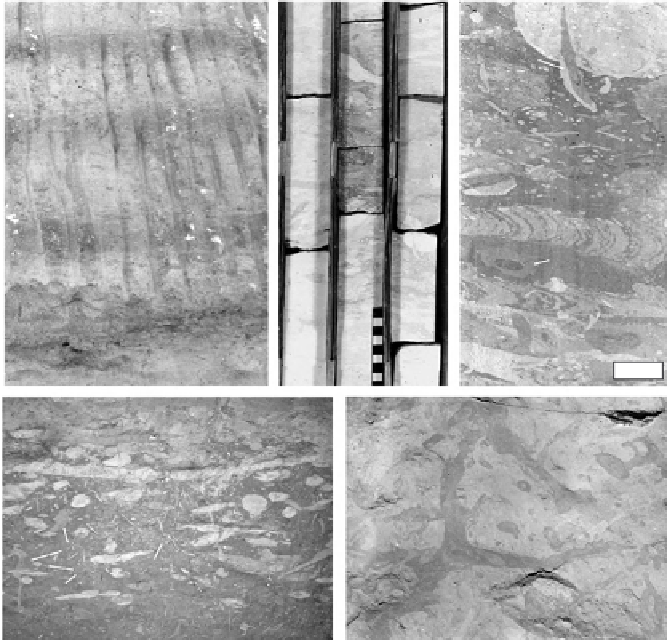Environmental Engineering Reference
In-Depth Information
A
B
C
Th
Te
Chalk
Marl
Ch
Marl
Zo
Ta
Chalk
1 cm
D
E
Zo
Th
Th
Te
Pl
Ch
5 cm
5 cm
FIGURE 5
Zoophycos
Ichnofacies manifested in rhythmically bedded, outer-shelf chalk and marl
of the Campanian Demopolis Chalk, Alabama, USA (see
Locklair and Savrda, 1998a,b
). (A) and (B)
Decimeter-scale rhythmic alternation of lighter chalks and darker marls, manifested in outcrop (A)
and core (B), reflecting siliciclastic dilution cycles mediated by orbital precession. Note the blurred
bed boundaries associated with thorough bioturbation and improved visibility of trace fossils at
chalk-marl and marl-chalk transitions. Despite variations in the sediment character, chalk and marl
beds in the Demopolis Chalk contain the same ichnocoenosis (exposure in A is
2.5 m high; scale in
B is graduated in cm). (C) and (D) Trace fossils expressed in cross-sectional views of marl-chalk
transitions in core (C) and outcrop (D). Homogeneous background fabrics are cut by
Thalassinoides
(Th),
Zoophycos
(Zo),
Teichichnus
(Te),
Chondrites
(Ch),
Taenidium
(Ta),
Planolites
(Pl), and
Phy-
cosiphon
(not visible in photograph). (E) Bedding-parallel view of
Thalassinoides
(Th) and other
trace fossils in a chalk-marl transition.
Central Graben of the North Sea (
Danholt and Surlyk, 2004
). Ichnocoenoses
developed under progressively lower levels of benthic oxygenation are charac-
terized by progressively lower trace-fossil diversities. Reduction in diversity is
generally accompanied by decreases in burrow diameters and bioturbation
depths (
Figs. 3
B and
6
). Larger, shallow-tier structures such as
Thalassinoides
are normally the first structures to be excluded from ichnocoenoses as benthic
oxygenation decreases (e.g., compare
Fig. 6
B and C), while smaller diameter,





















Search WWH ::

Custom Search